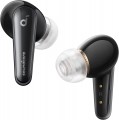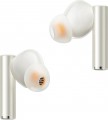Hi-Res Audio
Headphone support for Hi-Res Audio. The corresponding format is designed to provide a sound close to that recorded in the studio.
Hi-Res Audio refers to a digital signal with parameters from 96 kHz / 24 bits, and for analog technology, the requirement for an extended frequency response is set from 40 kHz. Audio tracks in this format sound as close as possible to the original ideas of the authors of the compositions. The Hi-Res license marks premium headphones for avid audiophiles.
Game mode (low input lag)
A special game mode in wireless headphones that minimizes the delay in transmitting an audio track from a connected source.
Low Input Lag) provides the ability to quickly respond to what is happening in virtual battles and prevents the picture from being out of sync with the sound. At the same time, when you activate the game mode, wireless headphones will be discharged faster.
Audio delay
Sound delay in wireless headphones is a natural process caused by the specifics of audio data transmission over Bluetooth. It can be either almost imperceptible or clearly interfere with comfortable gameplay or watching video content. This paragraph provides the declared sound delay time in milliseconds, which is written in the technical specifications for a particular headphone model.
Impedance
Impedance refers to the headphone's nominal resistance to AC current, such as an audio signal.
Other things being equal, a higher impedance reduces distortion, but requires a more powerful amplifier — otherwise the headphones simply will not be able to produce sufficient volume. Thus, the choice of resistance depends primarily on which signal source you plan to connect the "ears". So, for a portable gadget (smartphone, pocket player), an indicator of
16 ohms or less is considered optimal,
17 – 32 ohms is not bad. Higher values —
33 – 64 ohms and
65 – 96 ohms — will require quite powerful amplifiers, like those used in computers and televisions. And models with a resistance of
96 – 250 ohms and
above are designed mainly for Hi-End audio equipment and professional use; for such cases, detailed recommendations for selection can be found in special sources.
Frequency range
The range of sound frequencies that headphones can reproduce.
The
wider this range, the more fully the headphones reproduce the spectrum of sound frequencies, the lower the likelihood that too low or too high frequencies will be inaccessible. However, there are some nuances to consider here. First of all, let us remind you that the perceptual range of the human ear is on average from 16 Hz to 22 kHz, and for the complete picture it is enough for headphones to cover this range. However, modern models can significantly exceed these boundaries: in many devices the lower threshold
does not exceed 15 Hz, or even
10 Hz, and the upper limit can reach
25 kHz,
30 kHz and even
more. Such wide ranges in themselves do not provide practical advantages, but they usually indicate a high class of headphones, and are sometimes given only for advertising purposes.
The second important point is that a wide frequency range in itself is not a guarantee of good sound: sound quality also depends on a number of parameters, primarily the amplitude-frequency response of the headphones.
Emitter type
The type of sound emitters installed in the headphones. The type determines the principle of operation of emitters and some features of their design.
—
Dynamic. The simplest type of emitters operating on the principle of an electromagnet. Due to the combination of low cost with quite decent performance, it is also the most common, especially among entry-level and mid-range headphones. Such an emitter consists of a magnet, a coil placed in its field, and a membrane attached to the coil. When an alternating current (signal) enters the coil, it begins to vibrate, transmitting vibrations to the membrane and creating sound. From an acoustic point of view, the main advantages of dynamic radiators are a wide frequency range and good volume, the disadvantage is a relatively high probability of distortion, especially with a worn membrane.
—
Reinforcing. A peculiar modification of dynamic emitters (see the relevant paragraph), used mainly in high-end in-ear headphones. The basis of the design of such a radiator is a U-shaped metal plate. One of its ends is fixed motionless, the second, movable, is located between the poles of a permanent magnet, and a coil is wound around it (closer to the crossbar), through which the signal current passes. Vibrating under the action of this current, the movable part of the plate transmits vibrations to a rigid membrane, with which it is connected by a thin need
...le. This technology allows you to achieve good volume and low distortion with a very small size of the earpiece itself. The disadvantages of reinforcing radiators, in addition to high cost, are uneven frequency response and a relatively narrow frequency range. However, in expensive headphones of this type, several emitters can be provided at once, including on a hybrid basis (see relevant paragraph).
— Hybrid. Hybrid devices are usually called devices that combine dynamic and reinforcing emitters. See above for more details on these varieties; and their combination is used to combine advantages and compensate for disadvantages. Usually, in such headphones there is only one dynamic emitter, it is responsible for low frequencies, and there can be several reinforcing ones, they share the midrange and high frequencies. This allows you to achieve a more uniform frequency response than in purely armature models, but it significantly affects the price.
— Planar. The design of emitters of this type includes two powerful permanent magnets, between which there is a thin film membrane. The shape of the headphones themselves can be either round (orthodynamic emitters) or rectangular (isodynamic). According to the principle of operation, such systems are similar to dynamic ones, with the adjustment for the fact that there is no coil in the design — its role is played by the membrane itself with applied conductive tracks, to which the audio signal is fed. Due to this, distortions associated with the uneven oscillations of the membrane are practically absent; in addition, the sound as a whole is clear and reliable, and the frequency response is uniform. The main disadvantages of planar magnetic headphones are high cost, increased requirements for signal quality, and rather large dimensions. In addition, they are somewhat inferior to dynamic ones in terms of volume and overall frequency range.
— Electrostatic. Like planar-magnetic (see the relevant paragraph), such emitters are designed according to the "sandwich" principle. However, the membrane in them is located not between the magnets, but between the metal grids, and is made of a very thin metallized film. An audio signal is connected to such a system in a special way, and the membrane begins to oscillate due to attraction and repulsion from the grids, creating sound. Electrostatic drivers achieve very high sound quality, low distortion, and high fidelity, but they are bulky, complex, and expensive to use. And it's not just the high cost of the headphones themselves — their operation requires additional matching amplifiers with a voltage range of hundreds or even thousands of volts, and such devices cost a lot, and have the appropriate dimensions.Microphone noise canceling
The presence of a noise reduction system in its own headphone microphone.
In accordance with the name, such a system is designed to eliminate extraneous noise - primarily during conversations. It is usually based on an electronic filter that passes the sound of a human voice and cuts off background sounds such as city noise, the rumble of wind in the microphone grille, etc. As a result, even in noisy environments, thanks to the
noise reduction of the microphone, speech is clear and intelligible; True, the system inevitably introduces distortions into the final sound, but they are not critical in this case.
— ENC. ENC (Environment Noise Cancellation) technology significantly reduces ambient noise with directional microphones. It is used both in gaming devices so that gamers can easily communicate in voice chat, and in TWS earphone models so that you can comfortably talk on the phone in a noisy environment.
— cVc. Microphone noise reduction cVc (Clear Voice Capture) is an advanced technology that is found mainly in expensive headphone models. cVc algorithms effectively suppress echo and noise from the environment. Sound processing using this technology is carried out at several levels at once - the algorithm determines the reference signal-to-noise level, automatically adjusts speech to the desired volume level, applies adaptive equalizers to process the entire voice, as well as specialized filters to remove
...low-frequency bubbling, sibilants and hissing.Volume control
The headphones have their own
volume control. Such a regulator can be placed both on the wire and on one of the cups (the latter is typical for wireless models). Anyway, this function allows you to easily adjust the volume: for this you do not need to go into the computer settings, press the buttons on the player or smartphone, etc., just use the control at hand. On the other hand, additional equipment complicates and increases the cost of the design, and also increases the likelihood of distortion. In light of the latter, volume control is almost never found in professional headphones.
Voice assistant
Headphones with voice assistant support the user interaction with the device to a new level. The call of the
assistant. is carried out by pressing one of the control buttons on the headphones or by a specific voice command (for example, «Ok, Google» for the Google Assistant virtual apprentice). The assistant pauses playback, instantly changes the volume of the music, can notify the user of new alerts, helps to answer messages without the help of hands, and commands are given to the paired smartphone via voice control from the headphones.

